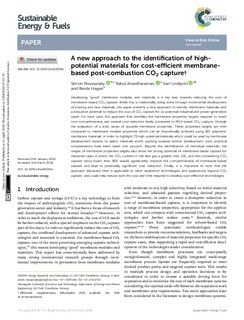| dc.contributor.author | Roussanaly, Simon | |
| dc.contributor.author | Anantharaman, Rahul | |
| dc.contributor.author | Lindqvist, Karl Erik Artur | |
| dc.contributor.author | Hagen, Brede Andre Larsen | |
| dc.date.accessioned | 2018-04-16T13:01:23Z | |
| dc.date.available | 2018-04-16T13:01:23Z | |
| dc.date.created | 2018-04-13T08:34:26Z | |
| dc.date.issued | 2018 | |
| dc.identifier.issn | 2398-4902 | |
| dc.identifier.uri | http://hdl.handle.net/11250/2494298 | |
| dc.description.abstract | Developing “good” membrane modules and materials is a key step towards reducing the cost of membrane-based CO2 capture. While this is traditionally being done through incremental development of existing and new materials, this paper presents a new approach to identify membrane materials with a disruptive potential to reduce the cost of CO2 capture for six potential industrial and power generation cases. For each case, this approach first identifies the membrane properties targets required to reach cost-competitiveness and several cost-reduction levels compared to MEA-based CO2 capture, through the evaluation of a wide range of possible membrane properties. These properties targets are then compared to membrane module properties which can be theoretically achieved using 401 polymeric membrane materials, in order to highlight 73 high-potential materials which could be used by membrane development experts to select materials worth pushing towards further development once practical considerations have been taken into account. Beyond the identification of individual materials, the ranges of membrane properties targets also show the strong potential of membrane-based capture for industrial cases in which the CO2 content in the flue gas is greater than 11%, and that considering CO2 capture ratios lower than 90% would significantly improve the competitiveness of membrane-based capture and lead to potentially significant cost reduction. Finally, it is important to note that the approach discussed here is applicable to other separation technologies and applications beyond CO2 capture, and could help reduce both the cost and time required to develop cost-effective technologies. | nb_NO |
| dc.language.iso | eng | nb_NO |
| dc.publisher | Royal Society of Chemistry | nb_NO |
| dc.rights | Navngivelse 4.0 Internasjonal | * |
| dc.rights.uri | http://creativecommons.org/licenses/by/4.0/deed.no | * |
| dc.title | A new approach to the identification of high-potential materials for cost-efficient membrane-based post-combustion CO2 capture | nb_NO |
| dc.type | Journal article | nb_NO |
| dc.type | Peer reviewed | nb_NO |
| dc.description.version | publishedVersion | nb_NO |
| dc.source.journal | Sustainable Energy & Fuels | nb_NO |
| dc.identifier.doi | 10.1039/C8SE00039E | |
| dc.identifier.cristin | 1579096 | |
| dc.relation.project | Norges forskningsråd: 193816 | nb_NO |
| dc.relation.project | Norges forskningsråd: 257529 | nb_NO |
| dc.description.localcode | Open Access Article. Published on 11 April 2018. This article is licensed under a Creative Commons Attribution 3.0 Unported Licence. | nb_NO |
| cristin.unitcode | 194,64,25,0 | |
| cristin.unitname | Institutt for energi- og prosessteknikk | |
| cristin.ispublished | true | |
| cristin.fulltext | original | |

